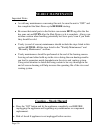
Page | 31
YEARLY MAINTENANCE
Exhaust Blower Cleaning
Although the exhaust blower and blower housing were designed to minimize ash
build, some fly-ash will still accumulate there throughout the burning season. The
amount and type of ash will depend on the type of pellets and venting system, but
generally this accumulation will be mild. If, when cleaning the exhaust blower, a
large accumulation of fly-ash is found, cleaning the exhaust blower and housing
should be performed monthly or bimonthly to prevent this excess buildup.
Instructions
• Before beginning the exhaust blower cleaning procedure, be certain the unit
is unplugged and thoroughly cooled down.
• In order to access the combustion blower, the unit will have to be at least
partially removed from the fireplace opening (or alternatively, the surround
kit and side panels can be removed to access the blower).
• Disconnect the venting system from the exhaust blower just enough that you
will be able to remove the exhaust blower from the stove.
• Unplug the two wires which connect the stove wiring harness to the exhaust
blower using the quick connect plugs.
• Loosen and remove the 5/16” screw, on the top of the exhaust blower output
connection, which holds the thermal sensor to the exhaust blower.
• Loosen the five (5) 5/16” self-drilling screws which hold the exhaust blower
to the exhaust blower tube. The lower screws are most easily accessed
through the circular cutouts in the stove body. A 12” socket extension will
likely be necessary to reach all of the screws.
• Lift the exhaust blower up and out of the stove. The gasket which seals the
exhaust blower to the exhaust blower tube is fragile, so take extra care when
removing the blower. Even when being careful though, it is easy to tear this
fragile gasket, and since an airtight seal is crucial here, it is best to replace
this gasket (Part Number – PU-CBG) every time the exhaust blower is
removed.


















